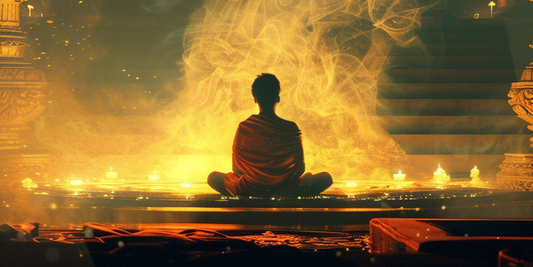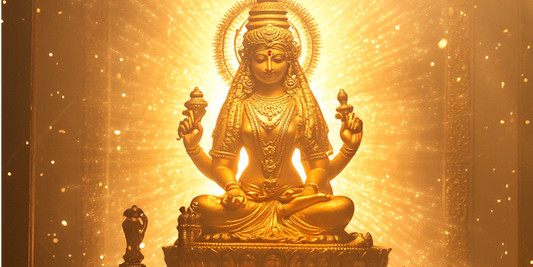
Ma Skandamata: Warrior Mother of a Warrior Son
The Union of Shiva and Shakti
When Ma Parvati took the powerful form of Devi Chandraghanta and defeated the bat-demon Jatakasura, it shook the demon world. Tarakasura trembled with fear. He had once felt safe, protected by a boon from Lord Brahma that said only the son of Lord Shiva and Shakti could defeat him. But now, with his trusted ally gone, that threat felt real. Tarakasura knew things were beginning to change.
Meanwhile, Devas and Gods were eagerly waiting for the son of Lord Shiva and Shakti, who would be a person of great courage, strength, and wisdom. The Divine Couple performed intense austerities to create such a divine being with their Tapo Shakti (power of penance).
It so happened that when Lord Shiva and Ma Parvati were meditating, a flame set forth from their foreheads. It merged to form a great ball of fire. Lord Shiva instructed Agnidev (God of Fire) to take this fireball to a safe place. However, the ball was so hot that even Agni could not carry it, and accidentally dropped into the River Ganga. Even Ma Ganga found it difficult to carry this fiery ball of energy and placed it in a forest of reeds called “Saravana” or “Sarkanda.”
The Birth of Skanda
As soon as Ma Ganga placed the fireball on the reeds, a beautiful baby emerged. Six of the seven brightest stars of Krittika nakshatra (Pleiades constellation) saw him. The baby was so lovely that they felt a strong urge to become his mothers. All of them wanted to take care of the baby and nurse him. The dispute ended when the baby grew five more heads— in order to have a total of six— so that he could look at all six mothers and let them each nurse one aspect of him. After a while, Ma Parvati visited the forest of reeds and took the child in Her loving embrace
Found in the reeds or ‘Sarkanda,’ this baby came to be known as Skanda.

Lord Skanda: References in Scriptures and Literature
In Kalidasa’s epic poem, Kumarasambhava, as in many versions of the story, the gods longed for the birth of Skanda—the only one who could defeat the powerful demons Taraka, Simhamukha, and Surapadma. These demons had a boon: only the son of Lord Shiva could kill them. Born from the union of Shiva and Shakti, Skanda came into the world for this very purpose.
Skanda is known by many names; each tells a part of his story. He is Kartikeya because he was raised by the Krittikas (the six celestial mothers). He is Gangeya because Ma Ganga sheltered him. He is Saravana Bhava, as he was born among reeds in a lake of white lotuses. He is Kumara, the ever-youthful one. He represents beauty, strength, and charm. As the son of Ma Gauri, he is also called Gauri Tanaya.
In Southern India, he is deeply loved as Murugan and Subrahmanya. His name, Skanda, also means ‘the one who stops’ or ‘the one who destroys’—for he ends the sufferings of his devotee.
References to Lord Skanda's childhood are found in many Puranas.
He is said to have given a discourse about the meaning of Pranava (the sacred syllable, Om) to Lord Shiva Himself. Thus, Lord Murugan also gained the name 'Swaminathan— the One who has been a master to Swami (Lord Shiva).
Lord Skanda: The Warrior God
When the time came for Skanda to fight with Tarakasura, Lord Shiva gave him many unique weapons. Skanda carried them in his eleven hands. In his twelfth hand, he carried the Shakti weapon or ‘Vel’ given by Ma Parvati. She wisely guided him during his battle with Tarakasura. Due to the ‘Vel’, ’Skanda is lovingly called Vel Murugan.
Skanda represents the coming together of Iccha Shakti (the power of intention), Jnana Shakti (the power of knowledge) and Kriya Shakti (the power of righteous action). When the Shiva Tattva unites with these three powers, then what emerges is Skanda.
We often say that the divine is everywhere and is omnipresent. But when you face a difficult situation in life, what do you do? What knowledge would you use then? In order to resolve the problem, you need to ACT. In other words, you need to put knowledge into action.
So, when we take an action that is guided by knowledge, the Skanda Tattva it gives rise to the Skanda Tatva. And thus, one of the swaroops of Mother Divine is Skandamata— the mother of the Skanda Tattva.






Comments
No comments yet. Be the first to share your thoughts.
Leave a comment